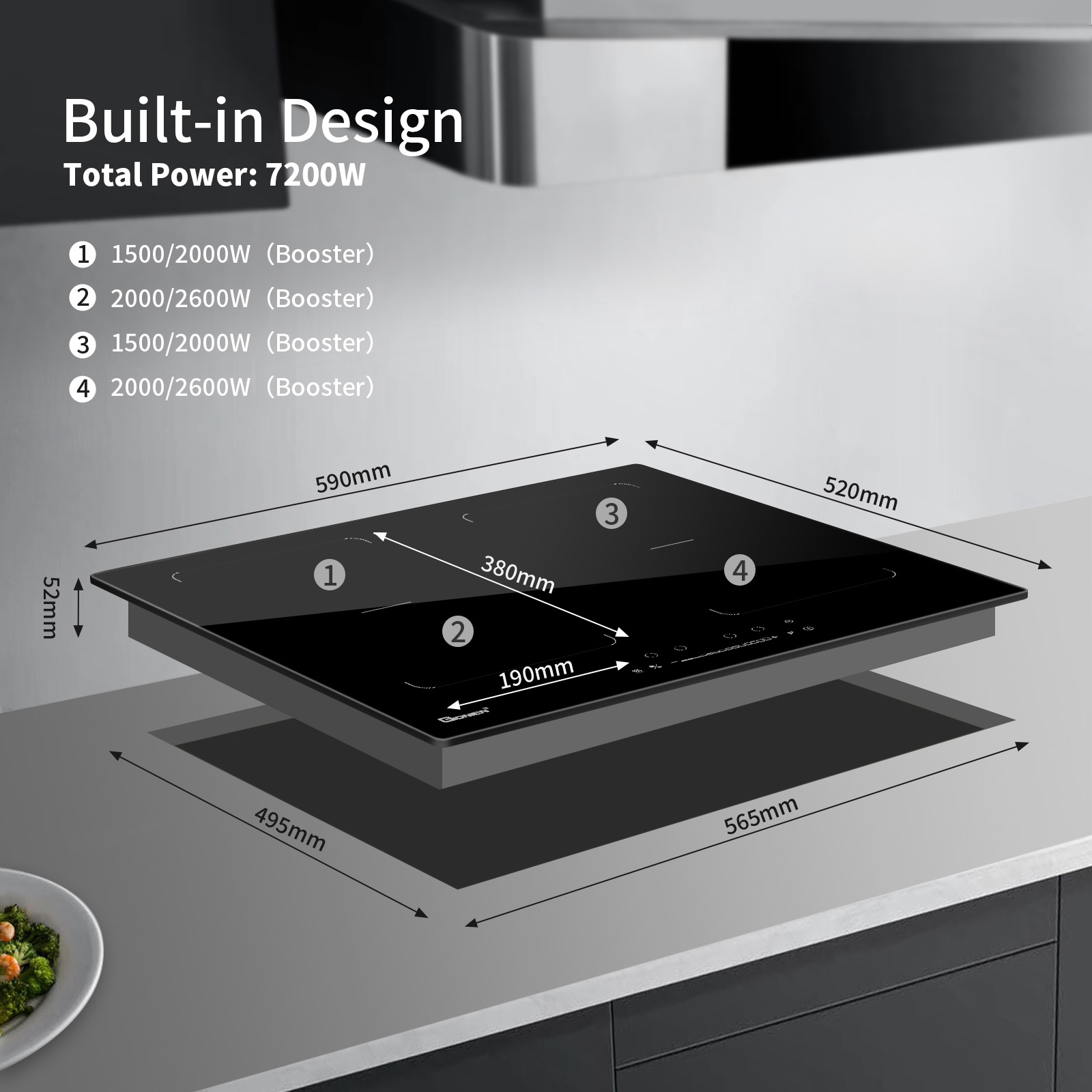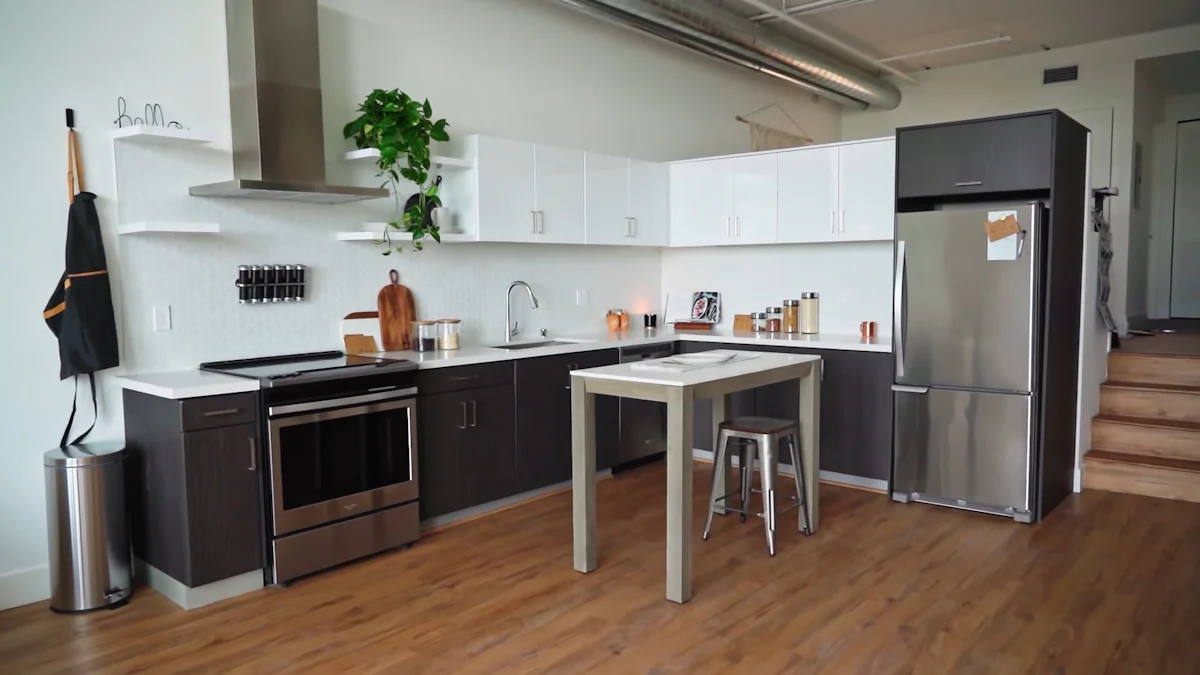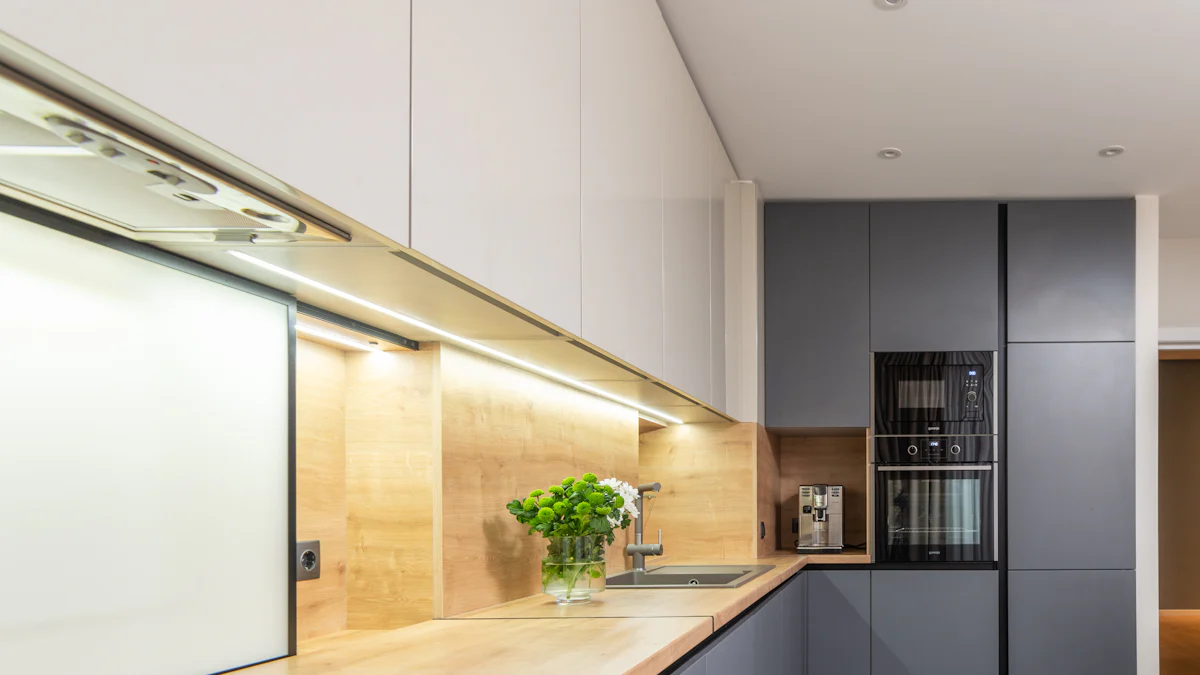Is a Built-in Induction Cooktop Right for Your Kitchen?
Imagine a cooking experience where speed, precision, and efficiency come together seamlessly. A built in induction cooktop offers exactly that. It heats your pots and pans directly, transferring up to 85% of the energy to your food, compared to just 30% with gas stoves. This means faster cooking times and less wasted energy. You’ll also enjoy a safer kitchen, as the surface stays cool to the touch. Plus, its sleek design adds a modern touch to any space. If you value performance and style, this might be the upgrade your kitchen needs.

Key Takeaways
Induction cooktops offer exceptional energy efficiency, transferring up to 95% of energy directly to cookware, which can lead to lower utility bills.
Safety is a major advantage; the cooktop surface remains cool to the touch, reducing the risk of burns, making it ideal for families with children or pets.
These cooktops heat up quickly and provide precise temperature control, allowing for faster cooking times and consistent results.
The sleek, modern design of built-in induction cooktops enhances kitchen aesthetics, integrating seamlessly into countertops for a clean look.
Consider your cookware compatibility; only pots and pans made from ferrous metals work with induction cooktops, so you may need to invest in new cookware.
Installation may require professional help to meet electrical requirements and ensure a perfect fit, which can add to the initial cost.
Induction cooking is a sustainable choice, producing no harmful emissions and allowing for the use of renewable energy sources, making it an eco-friendly option.
What is a Built-in Induction Cooktop?

A built-in induction cooktop is a modern cooking appliance that combines efficiency, precision, and style. Unlike traditional gas or electric stoves, it uses electromagnetic energy to directly heat your cookware. This innovative technology ensures faster cooking times, consistent results, and minimal energy waste. Its sleek design integrates seamlessly into your kitchen countertop, giving your space a clean and contemporary look.
Understanding Induction Cooktops
Induction cooktops work differently from conventional stoves. Instead of heating the burner, they generate heat directly in the cookware through electromagnetic fields. This method allows for precise temperature control, so you can simmer delicate sauces or sear steaks with ease. The heat adjusts almost instantly, offering responsiveness that’s hard to match with gas or electric options.
One standout benefit of induction cooking is its safety. The surface of the hob stays cool to the touch, reducing the risk of burns. It only heats the pan when it’s in contact with the induction zone, making it a safer choice for families with kids or pets. Additionally, induction cooktops are energy-efficient, transferring up to 95% of the energy to the cookware, compared to the 30% efficiency of gas stoves.
Features of a Built-in Induction Cooktops
Built-in induction hobs come packed with advanced features that elevate your cooking experience. Here are some key highlights:
Precise Temperature Control: You can adjust the heat with pinpoint accuracy, ensuring even cooking and preventing hot spots.
Quick Heating and Cooling: Induction cooktops bring water to a boil 20-40% faster than gas or electric stoves. They also cool down quickly when you turn off the heat.
Multiple Cooking Zones: Many models, like the THOR Kitchen 30 Inch Built-In Induction Cooktop, offer multiple heating elements. This allows you to cook several dishes simultaneously.
Touch Controls and Smart Technology: Built-in induction hobs often feature touch controls, timers, and power boost options for added convenience.
Sleek Design: Their flush installation creates a seamless look, making them a favorite among design enthusiasts.
Safety Features: Child locks, automatic shut-off, and cool-to-touch surfaces make these cooktops one of the safest options available.
Top induction cooktop brands have perfected this technology over decades, making it a reliable and luxurious addition to any kitchen. Whether you’re a home cook or a professional chef, the versatility and efficiency of a built-in induction hob can transform your cooking routine.
Pros and Cons of Built-in Induction Cooktops
When deciding if a built-in induction hob is the right fit for your kitchen, understanding its strengths and weaknesses is essential. Let’s break down the pros and cons to help you make an informed choice.
Advantages of Built-in Induction Cooktops
Faster cooking with precise temperature control
Induction cooktops excel in speed and precision. They heat up almost instantly, cutting down cooking times significantly. Boiling water, for instance, takes just a fraction of the time compared to gas or electric stoves. The precise temperature controls allow you to simmer delicate sauces or sear meats with accuracy. This level of control ensures even heating, so your dishes turn out perfectly every time.
Energy efficiency and reduced energy wastage
If you’re looking for energy savings, induction cooktops are a game-changer. They transfer heat directly to the cookware, minimizing wasted energy. Traditional gas stoves lose up to 70% of their energy as heat escapes into the air. In contrast, induction cooktops are highly energy efficient, using up to 95% of the energy to cook your food. This not only benefits the environment but also reduces your utility bills over time.
Enhanced safety with cool-to-touch surfaces
Safety is a standout feature of induction cooking. The surface of the hob stays cool to the touch, even when in use. It only heats the cookware, reducing the risk of burns or accidental fires. This makes it an excellent choice for families with children or pets. Many models also include additional improved safety features like child locks and automatic shut-off, giving you peace of mind while cooking.
Sleek, modern, and easy-to-clean design
A built-in induction hob adds a touch of elegance to your kitchen. Its flush installation creates a seamless, modern look that complements any design style. Beyond aesthetics, these cooktops are easy to clean. Spills don’t burn onto the surface since the hob itself doesn’t get hot. A quick wipe is all it takes for easy cleanup, saving you time and effort during post-meal cleaning.
Disadvantages of Built-in Induction Cooktops
Higher upfront cost and installation expenses
One of the biggest drawbacks of induction cooktops is their cost. The initial investment for a built-in induction hob can be significantly higher than traditional gas or electric stoves. Installation may also require professional assistance, adding to the expense. While the cost savings from energy efficiency can offset this over time, the upfront price might be a barrier for some.
Limited cookware compatibility
Not all pots and pans work with induction cooktops. Only cookware made of ferrous metals, like cast iron or stainless steel, is compatible. If your current cookware isn’t induction-ready, you’ll need to invest in new pieces, which can add to the overall cost. Checking for compatibility before making the switch is crucial.
Dependence on electricity and power availability
Induction cooktops rely entirely on electricity. If you live in an area prone to power outages, this could be a significant inconvenience. Unlike gas stoves, which can function during a blackout, induction cooktops become unusable without electricity. This dependence on power is something to consider when evaluating their performance in your kitchen.
Weighing the pros and cons of a built-in induction hob helps you determine if it aligns with your cooking needs and lifestyle. While the performance, efficiency, and safety features are impressive, factors like cost and cookware requirements might influence your decision. Carefully consider these aspects to decide if induction cooking is the right choice for you.
Is Your Kitchen Ready for a Built-in Induction Cooktop?

Upgrading to a built-in induction cooktop can transform your kitchen, but preparation is key. Before making the leap, you’ll need to evaluate your kitchen’s setup, budget, and cookware. Let’s explore what you should consider to ensure a smooth transition.
Electrical and Installation Requirements
Installing an induction cooktop isn’t as simple as plugging it in. It demands specific electrical requirements. Most induction cooktops require a dedicated circuit with a higher voltage, typically 220-240 volts. If your kitchen doesn’t already have this setup, you’ll need an electrician to upgrade your wiring. This step ensures the cooktop operates safely and efficiently.
Proper installation also plays a crucial role. Built-in induction cooktops must fit seamlessly into your countertop. Precise measurements are essential to avoid gaps or uneven surfaces. Professional installation is often recommended to achieve that sleek, flush look. While this adds to the upfront cost, it guarantees a polished finish and optimal performance.
Chef Lorenzo Beronilla, winner of Top Chef Amateur, emphasizes the importance of proper installation. He says, “A well-installed induction cooktop not only enhances your cooking experience but also elevates the overall aesthetic of your kitchen.”
Kitchen Layout and Space Considerations
Your kitchen’s layout significantly impacts whether a built-in induction cooktop is the right choice. These cooktops integrate directly into your countertop, so you’ll need sufficient space for installation. Measure your available counter area carefully. Standard sizes range from 24 to 36 inches, but larger models are available for those who need multiple cooking zones.
Think about your cooking habits too. Do you often prepare meals for a large family? If so, a cooktop with more burners might suit your needs better. On the other hand, if you cook for one or two people, a smaller model could save space without compromising functionality.
Ventilation is another factor to consider. Induction cooktops don’t produce open flames, but they still generate heat. Adequate ventilation ensures your kitchen stays comfortable while you cook. If your current setup lacks proper airflow, you may need to invest in a range hood or other ventilation solutions.
Budget and Cookware Compatibility
Budget plays a big role in deciding if induction cooking is right for you. Built-in induction cooktops come with a higher price tag compared to traditional gas or electric stoves. The cost doesn’t stop at the appliance itself. Professional installation and potential electrical upgrades add to the expense. However, the long-term savings on energy bills can offset these initial costs.
Another important consideration is cookware. Induction cooktops require magnetic cookware to function. If your current pots and pans aren’t compatible, you’ll need to purchase new ones. Look for items labeled as the best cookware for induction cooking, such as cast iron or stainless steel with a magnetic base. To test your existing cookware, hold a magnet to the bottom. If it sticks, it’s compatible.
Switching to induction might feel like a significant investment, but the benefits often outweigh the costs. The energy efficiency, precise temperature control, and sleek design make it a worthwhile upgrade for many home cooks.
Preparing your kitchen for a built-in induction cooktop ensures you’ll enjoy all the benefits without unexpected challenges. By addressing electrical needs, evaluating your kitchen layout, and considering your budget and cookware, you’ll set yourself up for a seamless transition to induction cooking.
Who Should Consider a Built-in Induction Cooktop?
Home Cooks Seeking Efficiency and Precision
If you love cooking and want to make your time in the kitchen more productive, induction cooktops are a game-changer. These cooktops heat up quickly, allowing you to boil water or sear meats in record time. The precise temperature control ensures your sauces won’t burn, and your steaks will cook evenly. You’ll have the ability to adjust the heat instantly, which is perfect for recipes that require careful attention.
One home cook from California shared their experience:
“I cook every day, and the induction cooktop is just so fast to heat and so easy to clean.”
This speed and ease of use make induction an excellent choice for anyone who spends a lot of time preparing meals. Whether you’re a beginner or an experienced chef, you’ll appreciate how these cooktops simplify your cooking process while delivering consistent results.
Design Enthusiasts Looking for a Modern Kitchen
If you’re someone who values aesthetics as much as functionality, a built-in induction cooktop will elevate your kitchen’s design. These cooktops feature a sleek, minimalist look that blends seamlessly into your countertop. The smooth glass surface adds a touch of sophistication, making your kitchen feel modern and stylish.
Many models also come with advanced touch controls and smart features, enhancing both the appearance and usability of your cooking space. The flush installation eliminates bulky edges, creating a clean and streamlined look. If you’re planning a kitchen remodel or simply want to upgrade your space, an induction cooktop can be the centerpiece of your design.
Families Prioritizing Safety and Convenience
For families, safety in the kitchen is always a top priority. Induction cooktops offer peace of mind with their cool-to-touch surfaces. Unlike traditional stoves, the cooking zone only heats the pan, reducing the risk of burns. This feature is especially helpful if you have young children or pets who might wander into the kitchen while you’re cooking.
Many induction models also include child locks and automatic shut-off functions, adding an extra layer of protection. Beyond safety, these cooktops are incredibly convenient. Spills don’t burn onto the surface, so cleaning is as simple as wiping it down with a cloth. If you’re juggling a busy household, the combination of safety and ease of maintenance makes induction cooktops a practical choice.
Whether you’re a passionate home cook, a design enthusiast, or a parent looking for a safer kitchen, a built-in induction cooktop offers something for everyone. Its speed, precision, and modern design make it a versatile addition to any home.
Environmentally Conscious Individuals
If you care about reducing your carbon footprint, a built-in induction cooktop aligns perfectly with your values. These cooktops are among the most energy-efficient cooking appliances available. Unlike gas stoves that waste up to 70% of their energy, induction transfers nearly all its energy directly to your cookware. This efficiency means less energy consumption and a smaller environmental impact.
Induction cooking also eliminates harmful emissions. Gas stoves release carbon dioxide and other pollutants into your home, contributing to indoor air pollution. Induction cooktops, on the other hand, rely solely on electricity, producing no direct emissions. By switching to induction, you create a cleaner and healthier cooking environment while supporting a greener planet.
Another benefit is the potential to pair your induction cooktop with renewable energy sources. If your home uses solar panels or wind energy, your cooking becomes even more sustainable. You’re not just saving energy—you’re cooking with clean energy. This combination makes induction an excellent choice for anyone striving to live an eco-friendly lifestyle.
A home cook from California shared their experience:
“I cook every day, and the induction cooktop is just so fast to heat and so easy to clean.”
This speed not only saves time but also reduces the energy required for cooking. Faster heating means less electricity used, which further minimizes your environmental impact. Plus, the easy-to-clean surface reduces the need for harsh chemical cleaners, adding another layer of eco-friendliness to your kitchen routine.
Choosing an induction cooktop isn’t just about upgrading your kitchen—it’s about making a conscious decision to support sustainability. By investing in this technology, you’re taking a step toward a more energy-efficient and environmentally responsible lifestyle.
A built in induction cooktop can revolutionize your cooking experience. It offers faster cooking, energy efficiency, and a sleek design that enhances your kitchen’s aesthetics. Its surface remains cool, making it safer and easy to clean after meals. However, the higher upfront cost and the need for compatible cookware might require careful consideration. Think about your cooking habits, budget, and kitchen layout before deciding. If you value precision, safety, and modern convenience, this could be the perfect addition to your home.
FAQ
What makes induction cooktops safer than traditional stoves?
Induction cooktops only heat the cookware, not the surface itself. This keeps the cooking zone cool to the touch, reducing the risk of burns. They also include safety features like child locks and automatic shut-off, making them ideal for families with kids or pets.
Do induction cooktops really save energy?
Yes, they are highly energy-efficient. Induction cooktops transfer up to 95% of the energy directly to your cookware, compared to gas stoves, which lose about 70% of their energy as heat. This efficiency helps lower utility bills and reduces energy waste.
Can I use my current cookware on an induction cooktop?
Not all cookware works with induction. Only pots and pans made from ferrous metals, like cast iron or stainless steel, are compatible. To check, hold a magnet to the bottom of your cookware. If it sticks, it’s induction-ready.
Are induction cooktops difficult to clean?
Not at all! The smooth glass surface makes cleaning a breeze. Since the cooktop itself doesn’t get hot, spills won’t burn onto the surface. A quick wipe with a damp cloth is usually all you need to keep it spotless.
Do induction cooktops heat faster than gas or electric stoves?
Yes, they heat much faster. Induction cooktops can boil water in nearly half the time it takes on a gas or electric stove. The heat adjusts instantly, giving you precise control for tasks like simmering or searing.
Will an induction cooktop fit into my kitchen layout?
Built-in induction cooktops integrate seamlessly into most countertops. They come in various sizes, typically ranging from 24 to 36 inches. Measure your available space carefully and consult a professional installer for a perfect fit.
What are the long-term benefits of using an induction cooktop?
Induction cooktops offer several long-term advantages. They save energy, reduce cooking times, and lower utility costs. Their durable design ensures they last for years, making them a smart investment for your kitchen.
How do induction cooktops contribute to sustainability?
Induction cooktops minimize energy wastage by delivering heat directly to the cookware. They also eliminate harmful emissions, unlike gas stoves, which release pollutants into your home. Pairing them with renewable energy sources, like solar panels, makes them even more eco-friendly.
Are induction cooktops worth the higher upfront cost?
While induction cooktops have a higher initial price, their energy efficiency and durability often offset the cost over time. You’ll save on utility bills and enjoy a modern, efficient cooking experience that lasts for years.
Can induction cooktops handle heavy-duty cooking?
Absolutely! Many models feature multiple cooking zones and power boost options, allowing you to cook several dishes simultaneously. Their precise temperature control ensures consistent results, whether you’re simmering sauces or preparing a large family meal.

